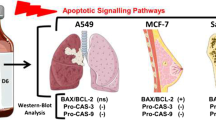Anticancer peptides are among the most important bioactive peptides found in animal sources. The modulation of the molecular process of apoptosis via the genes involved in the signaling pathway is now being studied for cancer treatment. In this study, the anticancer properties of peptide HL-10 extracted from scorpion venom by regulating the apoptosis signaling pathway were investigated. In the present study, the anticancer activity of the HL-10 peptide against the HeLa cancer cell line was assessed using the cytotoxicity assay. The real-time PCR method was used to analyse the expression levels of Bax, p53, caspase-3, PTEN, and Akt genes. The cytotoxicity assay demonstrated that the IC50 value of the HL-10 peptide was 40 μM. The results also showed that the treatment of Hela cells with HL-10 led to an increase in the expression of Bax, p53, caspase-3, and PTEN genes, while it resulted in a significant decrease in the expression level of the Akt gene in a dose-dependent manner (p.05). The flow cytometry analysis also revealed a high number of cells in the secondary apoptotic stage. According to changes in the expression of genes implicated in the apoptosis pathway, the HL-10 peptide appears to play a role in the activation of the intrinsic apoptosis pathway. However, additional research in molecular dimensions and clinical studies is needed. It is suggested to confirm the effectiveness of HL-10 peptide in cancer treatment.




Similar content being viewed by others
References
P. Anand, A. B. Kunnumakkara, C. Sundaram, et al., Pharma. Res., 25(9), 2097 – 2016 (2008).
R. Rahbari, T. Sheahan, V. Modes, et al., BioTechniques, 46(4), 277 – 284 (2009).
A. Capes, G. Theodosopoulos, I. Atkin, et al., Int. J. Cancer, 127(1), 1 – 8 (2010).
R. J. Youle, and A. Strasser, Nat. Rev. Mol. Cell. Biol., 9(1), 47 – 59 (2008).
M. Flórez, H. B. Fêo, G. Da Silva, et al., Vet. Comp. Oncol., 15, 793 – 807 (2017).
V. T. DeVita, and S. A. Rosenberg, N. Engl. J. Med., 366(23), 2207 – 2214 (2012).
M. Ejtehadifar, R. Halabian, A. A. I. Fooladi, et al., Microb. Pathog., 113, 438 – 444 (2017).
F. Schweizer, Eur. J. Pharmacol., 625(1 – 3), 190 – 194 (2009).
Z. Setayesh-Mehr, and A. Asoodeh, Int. J. Pept. Res. Ther., 25, 1343 – 1341 (2019).
Z. Setayesh-Mehr, A. Asoodeh, M. Poorsargol, Biologia, 76, 2735 – 2743 (2021).
Z. Setayesh-Mehr and A. Asoodeh, Int. J. Pept. Res. Ther., 25(40), 1343 – 1341 (2019).
Z. Setayesh-Mehr and A. Asoodeh, Bioorg. Chem., 75, 30 – 37 (2017).
H. Keshavarz Alikhani, J. Zargan, A. Bidmeshkipour, et al., Mod. Med. Lab. J., 4, 28 – 35 (2021).
A. L. Tornesello, A. Borrelli, L. Buonaguro, et al., Molecules, 25(12), 2850 (2020).
C. Li, H. Liu, Y. Yang, et al., Front. Pharmacol., 13(9), 1297 (2018).
M. Illescas, A. Peñas, J. Arenas, et al., Front. Cell Dev. Biol., 9, 95838 (2021).
H. M. Kuo, C. C. Tseng, N. F. Chen, et al., Mar. Drugs, 16(1), 8 (2018).
S. Liu, J. J. Aweya, L. Zheng, et al., Cell. Biol. Toxicol., 38(1), 87 – 110 (2022).
M. Jo, M. H. Park, P. S. Kollipara, et al., Toxicol. Applied Pharmacol., 258(1), 72 – 81 (2012).
L. Duprez, E. Wirawan, T. Vanden Berghe, et al., Microbes Infect., 11(13), 1050 – 1062 (2009).
F. M. Yakes, W. Chinratanalab, C. A. Ritter, et al., Cancer Res., 62(14), 4132 – 4141 (2002).
Y. Gu, S.-L. Liu, W.-Z. Yu, et al., Oncol. Lett., 5(2), 483 – 488 (2013).
G. Song, G. Ouyang, and S. Bao, J. Cell Mol. Med., 9(1), 59 – 71 (2005).
N. Majewski, V. Nogueira, R. B. Robey, et al., Mol. Cell Biol., 24(2), 730 – 740 (2004).
C. Li, H. Liu, Y. Yang, et al., Front. Pharmacol., 13(9), 1297 (2018).
Author information
Authors and Affiliations
Corresponding author
Rights and permissions
Springer Nature or its licensor (e.g. a society or other partner) holds exclusive rights to this article under a publishing agreement with the author(s) or other rightsholder(s); author self-archiving of the accepted manuscript version of this article is solely governed by the terms of such publishing agreement and applicable law.
About this article
Cite this article
Zahra, SM., Maryam, R. & Asghar, P. The Role of the HL-10 Peptide in Regulating the Expression of Apoptosis-Related Genes in the HeLa Cancer Cell Line. Pharm Chem J 57, 1929–1933 (2024). https://doi.org/10.1007/s11094-024-03098-x
Received:
Published:
Issue Date:
DOI: https://doi.org/10.1007/s11094-024-03098-x




